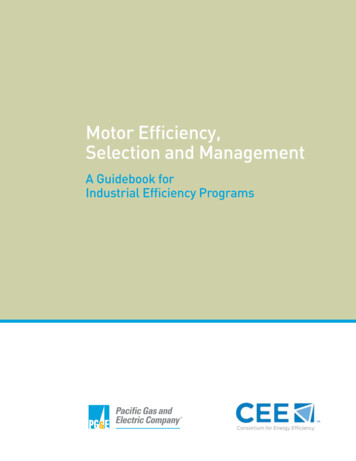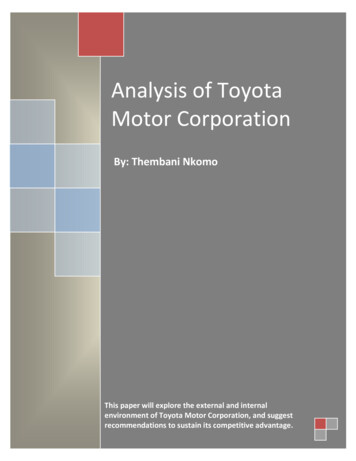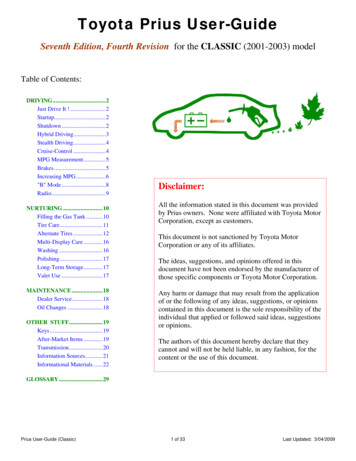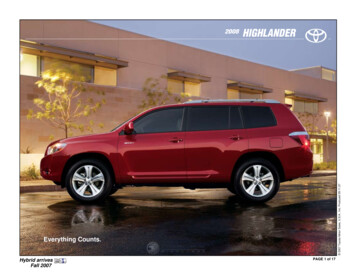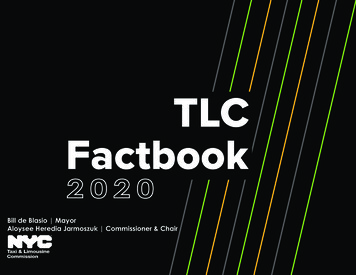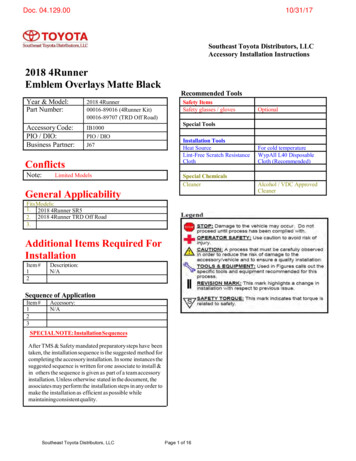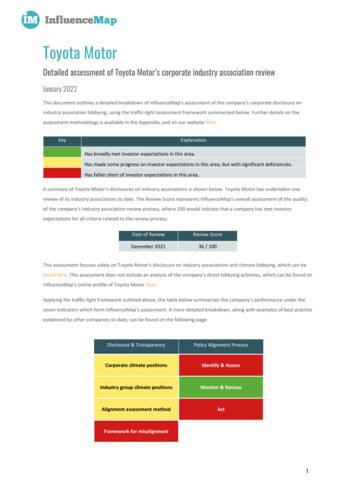
Transcription
Toyota MotorDetailed assessment of Toyota Motor’s corporate industry association reviewJanuary 2022This document outlines a detailed breakdown of InfluenceMap's assessment of the company's corporate disclosure onindustry association lobbying, using the traffic-light assessment framework summarized below. Further details on theassessment methodology is available in the Appendix, and on our website here.KeyExplanationHas broadly met investor expectations in this area.Has made some progress on investor expectations in this area, but with significant deficiencies.Has fallen short of investor expectations in this area.A summary of Toyota Motor’s disclosures on industry associations is shown below. Toyota Motor has undertaken onereview of its industry associations to date. The Review Score represents InfluenceMap’s overall assessment of the qualityof the company’s industry association review process, where 100 would indicate that a company has met investorexpectations for all criteria related to the review process.Date of ReviewReview ScoreDecember 202136 / 100This assessment focuses solely on Toyota Motor's disclosure on industry associations and climate lobbying, which can befound here. This assessment does not include an analysis of the company's direct lobbying activities, which can be found onInfluenceMap's online profile of Toyota Motor here.Applying the traffic-light framework outlined above, the table below summarizes the company’s performance under theseven indicators which form InfluenceMap’s assessment. A more detailed breakdown, along with examples of best practiceevidenced by other companies to date, can be found on the following page.Disclosure & TransparencyPolicy Alignment ProcessCorporate climate positionsIdentify & AssessIndustry group climate positionsMonitor & ReviewAlignment assessment methodActFramework for misalignment1
Toyota Motor’s Company ScorecardThe tables below highlight, for each indicator, the criteria for companies to meet investor expectations, ToyotaMotor’s assessment, and examples of better practice by companies to date.While InfluenceMap did not find an example of best practice across the entire industry association reviewprocess, some companies have demonstrated better practice under specific metrics under the 'Disclosure &Transparency' and 'Policy Alignment Process' assessments.Disclosure & TransparencyCorporate climate policy positions and influencing activitiesTo meet investor expectations under this indicator: The company has to disclose a detailed and clearly referencedbreakdown of its own climate policy positions and influencing activities beyond ‘top-line’ climate statements. Thisincludes descriptions of the company’s positions and policy engagement activities on specific items of regulation andlegislation which are material to the company’s operations, business sector, and/or the region(s) in which it operates.Toyota MotorToyota Motor has disclosed an overview of six high-level positions on climate change including theParis Agreement, carbon neutrality, renewable energy, the energy transition and zero-carbontechnologies, carbon tax and emissions trading, and GHG regulations. The company has alsodisclosed its position on, and engagement with, specific items of regulation and legislation in Japan(2030 energy mix under the Strategic Energy Plan, vehicle provisions within the Green GrowthStrategy) and the US (federal GHG emissions standards for passenger cars and light trucks, 2030 zeroemission vehicle target, electric vehicle tax incentive).Toyota Motor does not appear to have disclosed a position on specific items of regulation andlegislation which are material to the company’s operations. For example, Toyota Motor did notcomment on its position on the EU’s proposed 2035 zero-emissions CO2 target for cars and vans,which InfluenceMap’s database could not find any clear public disclosure on from Toyota in 2021.Toyota also did not comment on its stance regarding growing calls by governments (e.g. US State ofCalifornia, the UK) to phase out internal combustion engines, including hybrids, by 2030-35.Best PracticeShell has disclosed six detailed climate policy positions in its 2021 review including net-zero emissionsand carbon pricing. Shell’s 2020 update also outlined the company’s position on specific climatepolicies including the EU Green Deal and methane regulation in the EU and US. The 2021 review alsoincludes a clear reference to a list of climate policy positions and live advocacy updates on Shell’scorporate website.2
Industry association climate policy positions and influencing activitiesTo meet investor expectations under this indicator: The company has to disclose a detailed and accurate account of theclimate policy positions and influencing activities of each industry association actively engaged on climate change policy,including descriptions of positions and policy engagement activities on specific items of regulation and legislationbeyond ‘top-line’ statements.Toyota MotorToyota Motor has disclosed each industry association’s stance on the six high-level positions onclimate change outlined above, which includes examples of engagement on specific items ofregulation and legislation. For example, the company has disclosed some of JAMA’s and Keidanren’sengagement on Japan’s Sixth Strategic Energy Plan, and ACEA’s support for the EU Emissions TradingSystem. However, the disclosure appears to overlook detailed negative lobbying by its industryassociations. For example, Toyota has not disclosed ACEA’s opposition to an EU zero-emissions 2035CO2 target for cars and vans in a November 2021 EU consultation response. Toyota also does notappear to disclose a full and accurate account of JAMA’s and Keidanren’s positioning on renewableenergy policy and carbon pricing, respectively. While JAMA expressed top-level support for Japan’s2030 renewable target in its public comment on Japan’s Sixth Strategic Energy Plan, its supportappeared to be conditional on low cost and preferential incentives for industrial users. At the METIministerial hearing on the introduction of carbon pricing in Japan in April 2021, Keidanren opposedcarbon taxes and emissions trading, promoting the weaker voluntary credit market instead.Moreover, at an April 2021 hearing at METI, JAMA advocated for flexibilities, such as EV and offcyclecredits that may weaken the Japanese standards for light duty vehicles.Best PracticeNo companies have met investor expectations in this area, although BASF and Shell exhibit currentleading practice. Both companies have disclosed a detailed account of all key industry associations’climate policy positions, and a summary of their influencing activities. However, they appear tooverlook detailed negative lobbying by a number of industry associations identified byInfluenceMap's database.Alignment assessment methodTo meet investor expectations under this indicator: The company has to: (1) disclose a clear and detailed framework forassessing alignment with its industry associations across all relevant areas of policy engagement; (2) consistently applythis framework across all industry associations; and (3) provide a clear and detailed explanation behind each evaluation.Toyota MotorToyota Motor has disclosed a limited explanation of its alignment assessment methodology, outliningsix high-level policy positions which form the basis of the assessment, but without outlining whatconstitutes alignment with reference to these positions. However, the company has provided a clearexplanation of how the methodology has been applied to each industry association against the sixhigh-level policy positions.Best PracticeBASF has also disclosed a clear explanation of its alignment assessment method along with a clearand detailed explanation of how it has been applied to each industry association. The company alsoprovided specific alignment indicators for EU climate policy such as the EU ETS to assess thealignment of key European industry associations.3
Framework for addressing misalignmentTo meet investor expectations under this indicator: The company must disclose a clear and detailed framework foraddressing misalignments with its industry associations including escalation steps and clear deadlines for industryassociations which do not amend misaligned practices.Toyota MotorToyota Motor has not disclosed a clear and detailed framework to address potential cases ofmisalignment. The company states that, if an association’s advocacy is not aligned with its ownpositions, it will “increase our engagement with them to change their stance”. However, thisframework does not include escalation steps or clear deadlines for industry associations which do notamend misaligned practices.Best PracticeBHP has disclosed clear and detailed steps for addressing potential misalignment, including anescalation strategy and clear timelines attached. The company states it will communicate materialdifferences, request that the industry association develop a position or refrain from advocacy incertain areas, and review the membership if there has been no action within 12 months.Policy Alignment ProcessIdentify & AssessTo meet investor expectations under this indicator: The company has to identify all cases of misalignment with itsindustry associations and the Paris Agreement in line with InfluenceMap’s database on corporate lobbying.For its 2021 review, Toyota Motor has selected four industry associations which are highly influentialon climate related policies and strongly linked to the company: Japan Automobile ManufacturersAssociation (JAMA), Japan Business Federation (Keidanren), Alliance for Automotive Innovation (AutoInnovators), and European Automobile Manufacturers’ Association (ACEA). Toyota Motor has notidentified any cases of misalignment with the four industry associations. However, InfluenceMapanalysis finds they these associations have consistently lobbied against ambitious climate policy: JAMA: In 2021, opposed zero-emission CO2 standards for light-duty vehicles in the EU, as well ashigher standards for 2025, 2030, and 2035. Keidanren: In 2021, opposed carbon taxes and emissions trading and advocated for the continueduse of "high efficiency" coal and LNG in the energy mix.Toyota Motor Auto Innovators: In 2021, opposed higher US GHG emissions standards for vehicles, supportingonly a less ambitious mid-way option, alongside numerous exceptions to weaken the rule. ACEA: In 2021, opposed an EU zero-emissions 2035 CO2 target for cars and vans as well asincreased 2030 targets for light-duty vehicles.In total, InfluenceMap analysis indicates that the company likely has eight memberships to industryassociations misaligned with the Paris Agreement (JAMA, Keidanren, ACEA, California Chamber ofCommerce, National Association of Manufacturers, Automobile Association of Japan, Society of IndianAutomobile Manufacturers, Central Japan Economic Federation) and five memberships to industryassociations potentially misaligned with the Paris Agreement (Auto Innovators, Society of MotorManufacturers and Traders, Information Technology Industry Council, Hydrogen Europe,Confederation of British Industry).Best PracticeNo companies have met investor expectations in this area. InfluenceMap analysis indicates that allcompanies have missed key cases of misalignment with industry associations lobbying counter to thegoals of the Paris Agreement.4
Monitor & ReviewTo meet investor expectations under this indicator: The company has to publish a review of industry associations on anannual basis, commit to do so at least once a year, or commit to disclose regular updates on its review and alignmentprocess. Updates should accurately report on relevant material and on-going lobbying activities of potentially misalignedindustry associations, as well as the company’s alignment and engagement with the industry association concerning theseactivities.Toyota MotorBest PracticeToyota Motor has stated that it will update the contents of the review on an annual basis viaengagement with its stakeholders.Shell has published full industry association reviews in 2019 and 2021. In April 2020, Shell alsopublished an update on the nine associations with some misalignment found in 2019 including actionstaken within each association, key changes to the associations’ climate positions and detailed nextsteps. Shell has committed to publish its next update in 2022.ActTo meet investor expectations under this indicator: The company has to show evidence of action to address all cases ofmisalignment with its industry associations and the Paris Agreement, in line with InfluenceMap’s database on corporatelobbying. The investor expectations outlined by PRI, IIGCC and Ceres include several steps companies can take to addressmisalignment. Steps should include terminating memberships or taking specific action to reform the detailed and materiallobbying activities undertaken by misaligned organizations.Toyota MotorToyota Motor has shown no evidence of action to address specific misalignments. The companydisclosed that it will continue to engage in discussions with all four industry associations to achievecarbon neutrality by 2050, but with no further details provided. The company does not appear to haveaddressed key cases of material and potential misalignment with the Paris Agreement identified byInfluenceMap’s database (see Identify & Assess).Best PracticeNo companies have met investor expectations in this area by showing evidence of action to address allcases of misalignment identified by InfluenceMap’s database, although some companies have mademore progress. Total announced in January 2021 that it had decided not to renew its membership tothe American Petroleum Institute due to divergences on climate positions. BHP suspended itsmembership to Queensland Resources Council in 2020 following its ‘Vote Greens Last’ advertisingcampaign and outlined detailed actions to be taken at four "partly aligned" industry associations.Chevron has not left any industry associations but has disclosed its engagement on specific climatechange policy issues with seven industry associations, including details of the results of thisengagement. Similarly, General Motors has disclosed that it has not financially contributed toadvocacy campaigns against the Build Back Better Act by the Business Roundtable and US Chamber,and has publicly advocated a supportive position to ensure its stance is differentiated from them.5
Appendix A: Methodologies for AssessmentScoring Disclosures and Policy-AlignmentKeyExplanationHas broadly met investor expectations in this area.Has made some progress on investor expectations in this area, but with significant deficiencies.Has fallen short of investor expectations in this area.Assessing DisclosuresSince BHP’s 2017 industry association review, around 40 major global corporates have delivered similar,specific disclosures on their industry association links in response to investor pressure. This positivemomentum is undermined, however, if the resulting disclosures are of poor quality.In its ‘Investor Expectations on Corporate Climate Lobbying’ report, the PRI highlights the need for disclosureon the company’s positions and activities on climate change policy engagement, as well as the positions andactivities of the industry groups it supports. The PRI further requests information on the governance processesand actions taken to ensure alignment between these activities and the company’s stated climate goals. IIGCCand Ceres articulate similar expectations, also requiring companies to disclose a material impact assessment oflobbying by an organization that opposes their public position. InfluenceMap uses the following assessmentcriteria to test the clarity, accuracy and scope of information provided by companies against four key issues.Disclosure ItemCorporate climatepolicy positionsand influencingactivitiesScoreInfluenceMap’s Assessment CriteriaThe company has disclosed a detailed and clearly referenced breakdown of its ownclimate policy positions and influencing activities beyond ‘top-line’ climate statements.This includes descriptions of the company’s positions and policy engagement activitieson specific items of regulation and legislation which are material to the company’soperations, business sector, and/or the region(s) in which it operates.The company has disclosed a breakdown of its own climate policy positions andinfluencing activities. However, the company’s description of its positions and policyengagement activities on specific items of regulation and legislation lacks detail, and/orthe company has not disclosed its position and engagement activities on key items ofregulation and legislation which are material to its operations, business sector, and/orthe region(s) in which it operates.6
The company has made no attempt to disclose its climate policy positions andinfluencing activities, or the company’s disclosure is limited to a brief overview of its‘top-line’ climate statements and operational commitments without reference tospecific items of regulation and legislation.The company has disclosed a detailed and accurate account of the climate policypositions and influencing activities of each industry association actively engaged onclimate change policy, including descriptions of positions and policy engagementactivities on specific items of regulation and legislation beyond ‘top-line’ statements.Industryassociation climatepolicy positionsand influencingactivitiesThe company has disclosed an account of the climate policy positions and influencingactivities of each industry association actively engaged on climate change policy,beyond ‘top-line’ statements. However, the disclosure lacks detail on positions andpolicy engagement activities on specific items of regulation and legislation, and/or doesnot disclose evidence of negative climate lobbying by one or more of its industryassociations.The company has not disclosed the climate policy positions and influencing activities ofeach industry association actively engaged on climate change policy, and/or thecompany’s disclosure is limited to a brief overview of ‘top-line’ climate statementswithout reference to specific items of regulation and legislation.The company has: (1) disclosed a clear and detailed framework for assessing alignmentwith its industry associations across all relevant areas of policy engagement; (2)consistently applied this framework across all industry associations; and (3) provided aclear and detailed explanation behind each evaluation.AlignmentassessmentmethodThe company has disclosed a framework for assessing alignment with its industryassociations but the disclosure lacks detail regarding one of the above steps (1-3).The company has not disclosed a framework for assessing alignment with industryassociations, or it has disclosed a framework but the disclosure lacks detail regardingmore than one of the above steps (1-3).The company has disclosed a clear and detailed framework for addressingmisalignments with its industry associations including escalation steps and cleardeadlines for industry associations which do not amend misaligned practices.Framework foraddressingmisalignmentThe company has disclosed a clear and detailed framework for addressingmisalignments with its industry associations including escalation steps, but there is noclear deadlines for industry associations which do not amend misaligned practicesThe company has not disclosed a framework for addressing misalignments with itsindustry associations, or the company has disclosed a framework but the steps areambiguous and lack sufficient detail.Assessing Policy Alignment ProcessAs well as transparent disclosures on industry group links and lobbying activities, the investor expectationscommunicated by IIGCC, CERES and the UN PRI also set out the need for robust processes to ensure alignmentbetween the company’s stated policy positions and the positions and lobbying activities of their industrygroups. These processes consist of the following three elements:7
AlignmentProcessScoreInfluenceMap’s Assessment CriteriaThe company has identified all cases of misalignment with its industry associations and the ParisAgreement in line with InfluenceMap’s database on corporate lobbying.Identify &AssessThe company has not identified key cases of misalignment with the Paris Agreement in line withInfluenceMap’s database on corporate lobbying. Companies are scored in this category if they miss upto three cases of “potential” misalignment (industry associations with Organization Scores 51-75 inInfluenceMap’s database).The company has not identified key cases of misalignment with the Paris Agreement in line withInfluenceMap’s database on corporate lobbying. Companies are scored in this category if they miss onecase of misalignment (industry associations with Organization Scores 0-50) or more than three cases of“potential” misalignment (industry associations with Organization Scores 51-75 in InfluenceMap’sdatabase).The company has published a review of industry associations on an annual basis, has committed to doso at least once a year, or is/has committed to disclose regular updates on its review and alignmentprocess. Updates should accurately report on relevant material and on-going lobbying activities ofpotentially misaligned industry associations, as well as the company’s alignment and engagement withthe industry association concerning these activities.Monitor &ReviewThe company has committed to publish an update to its review of industry associations but not anannual basis or not specified a timeframe.The company has not committed to any follow-up processes as part of its review of industryassociations.The company has shown evidence of action to address all cases of misalignment with its industryassociations and the Paris Agreement, in line with InfluenceMap’s database on corporate lobbying. Theinvestor expectations outlined by PRI, IIGCC and Ceres include several steps companies can take toaddress misalignment. Steps should include terminating memberships or taking specific action toreform the detailed and material lobbying activities undertaken by misaligned organizations.ActThe company has shown some evidence of action to address cases of misalignment with its industryassociations and the Paris Agreement, but has not addressed key cases of misalignment or “potential”misalignment identified by InfluenceMap’s database on corporate lobbying, i.e. industry associationswith Organization Scores 0-75 in InfluenceMap’s database. The investor expectations outlined by PRI,IIGCC and Ceres include several steps companies can take to address misalignment. Steps shouldinclude terminating memberships or taking specific action to reform the detailed and material lobbyingactivities undertaken by misaligned organizations.The company has shown no or limited evidence of action to address cases of misalignment with itsindustry associations and the Paris Agreement, missing key cases of misalignment or potentialmisalignment identified in InfluenceMap’s database on corporate lobbying, i.e. industry associationswith Organization Scores 0-75. The investor expectations outlined by PRI, IIGCC and Ceres includeseveral steps companies can take to address misalignment. Action will be scored under this category ifit does not include terminating memberships or taking specific action to reform the detailed andmaterial lobbying activities undertaken by misaligned organizations.To assist this assessment, InfluenceMap will be applying its database on corporate and industry group climatechange lobbying. This tracks in real-time the detailed climate policy lobbying of around 300 companies and 100industry associations globally, allowing like-for-like comparisons of organizations’ positions on climate policythat are compared to a benchmark of Paris-aligned climate policy. This system can track the evolution ofcorporate and industry group climate lobbying positions over time.8
Toyota Motor's Company Scorecard The tables below highlight, for each indicator, the criteria for companies to meet investor expectations, Toyota Motor's assessment, and examples of better practice by companies to date. While InfluenceMap did not find an example of best practice across the entire industry association review

